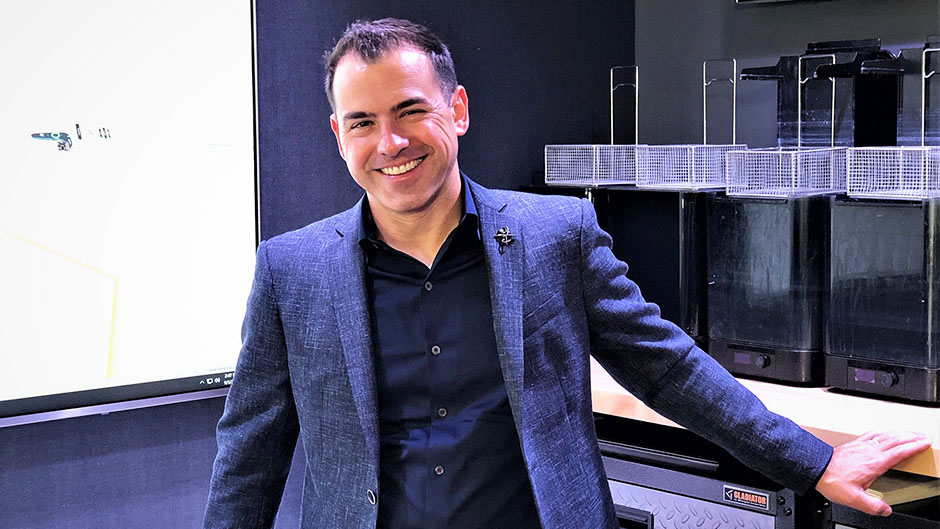Architecture blends artistry and functionality, shaping the spaces we inhabit and influencing the way we experience the world around us. For Christian Giordano, B.Arch. ’97, president and co-owner of Mancini Duffy, a national design firm based in New York City, architecture is not just a profession but a lifelong passion. In a recent conversation, Giordano shared insights into his architecture journey, highlighting the importance of early influences, technological evolution, and the creation of groundbreaking tools.
For many in the profession, the spark of fascination with architecture is ignited at a young age. Giordano is no exception. He recalled, “I think that with most architects, it’s just something that you’re interested in from very early on, whether that comes from Lego playing or model making or involvement around construction. My mother was obsessed with design and was always doing renovations in her house. I liked the construction part of it, and that sparked the idea.”
Throughout high school, he explored his passion for architecture through self-study and hands-on projects. “I would get architecture books. That is what I wanted for Christmas. And I did a lot of model-making,” he explained. He created intricate models, including remote-controlled cars, buildings, and even dollhouses for relatives. Despite not having formal architecture training or experience, Giordano’s early dedication to learning and honing his skills laid a solid foundation for his future career.
Giordano’s official architectural education began at the University of Miami, where he earned his Bachelor of Architecture degree, further cultivating his passion and developing essential skills. Giordano reflected on his time as a ’Cane, saying, “It was a great experience overall. I cherished that time for many reasons. There was a series of professors who were genuinely excited about architecture. They loved it.”
One key aspect of his Miami education was a focus on traditional architectural principles. This approach, focusing on drawing and physical models, would later prove to be a valuable asset in his career. Giordano explained, “At the University of Miami, there was an emphasis on historical architecture, proportion, drawing, and the hand-eye connection. That was a very informative way of learning for me.”
Even as technology advanced in the field, Giordano continued to rely on these traditional skills. “Still, to this day, when I sit down to design, I start out with pencil and paper,” he said.
Following his undergraduate studies at the University, Giordano pursued a master’s degree in architecture at the University of California, Los Angeles (UCLA). He explained how his education at the U provided a strong foundation, while UCLA exposed him to a different perspective. This well-rounded education, combining traditional and progressive schools of thought, prepared Giordano for the diverse opportunities he would encounter in his career.
As a ’Cane, Giordano secured an internship at the Miami branch of the architectural firm Swanke Hayden Connell Architects, originally based in New York. The owner of the firm, Richard Carlson, suggested that if he ever wanted a job in New York, he should reach out. Giordano later returned to New York, where he contacted Carlson and got his first job in the city, a decision that not only kick-started his career but also led him to meet his future wife. This Miami-to-New York connection played a pivotal role in shaping Giordano’s professional and personal life.
Through his commitment to improving the architectural process, Giordano created The Toolbelt, a patented software suite that revolutionizes collaborative 3D modeling and decision-making in architecture. Giordano explained the motivation behind The Toolbelt: “The hardest part of any design process is actually not doing the design. It’s helping the client make decisions.” He highlighted the conventional back-and-forth process in architecture in which design changes and client feedback often elongate project timelines.
Giordano envisioned a more efficient and collaborative approach. “What a normal architecture process can do in three weeks, we can do in three hours,” he said. The software lets clients make real-time design decisions, fostering cooperation and transparency. The Toolbelt’s impact has been profound, with Giordano stating that clients who experience its innovative processes never want to return to traditional methods. They appreciate the clarity and involvement in the design process, resulting in a seamless transition from design to the final product.
When thinking of young and aspiring architects, Giordano encourages them to gain hands-on experience through freelance work or personal projects. He believes these experiences help architects better understand client interactions and business management. He also noted that architects often don’t pursue the profession for monetary gain but instead for the love of design. He advised, “I think that for those looking to go into the field of architecture, it’s definitely something that you have to have a passion for.”
Giordano’s journey through the world of architecture underscores the power of early influences, a balanced education, and the pursuit of innovation. He hopes that through the transformative potential of technology and collaboration in architecture, he and his firm can benefit the entire industry for years to come.

